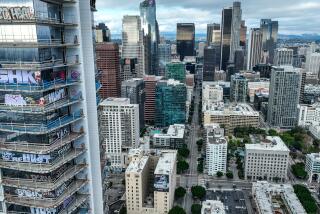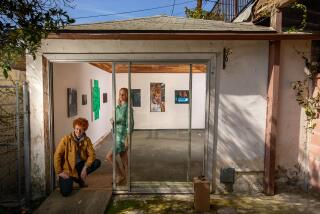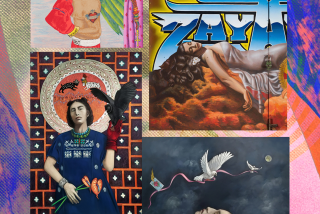Using Creativity, Not Politics, to ‘Bridge the Differences’ After Unrest
- Share via
“The Korean community needs to know that the elite of the spirit exists in the black community, and the black community needs to know that the elite of the spirit exists in the Korean community.”
So says curator Josine Ianco Starrels, who has organized what is potentially one of the most important exhibitions in the crop of politically themed art shows materializing in post-riot L.A.
The show, “Bridging the Differences: Works by African-American Artists,” opened Friday at the Korean Cultural Center on Wilshire Boulevard with work by six renowned artists, including Betye Saar, John Outterbridge and Raymond Saunders. Plans call for it to be followed next month by a show with Korean-American artists at the Watts Towers Art Center in South-Central Los Angeles.
But in an interesting twist to the debate over the role of art in the city’s political healing, many of the works presented in “Bridging the Differences” are among the least political of those being shown in riot-related shows.
“It’s just good art, because the minute you put politics first, it defeats the purpose,” Starrels said. “I didn’t think about it like a political move--I just thought that because there had been conflict (between the Korean-American and African-American) communities, it would be wonderful to bring them together.”
Such is the hope of not only Starrels and the artists involved, but also of the South Korean consulate itself, which has operated the exhibitions program at the center for 11 years, and is only now, for the first time, venturing to show work by other than Korean or Korean-American artists.
“I don’t think you would see this (exhibition) and necessarily think color, you would just think art, so that will allow people to get beyond (racial issues),” said Saunders, noting that political forces have encroached upon art to the point that he has been told by some that his own work is “not black enough.” “You don’t have to see a color to reach people--seeing a color just antagonizes other groups, and that destroys the sensibility of what you’re trying to do. . . . If the art comes first, then everybody can get the message.”
Another artist in the show, Matthew Thomas, noted that art presents a powerful message without being political in itself: “Artists are always creators, and this is a wonderful opportunity to create another bridge,” he said. “We’re not really politically oriented, but the principles we use can be taken up by others--principles like looking for similarities and differences in things and working to find harmony with those similarities and differences.”
Some of the work in “Bridging the Differences”--such as Willie Middlebrook’s photographs from his “Portraits of My People” series--has obvious African-American ties. But much of the remainder--such as Saar’s mixed-media “Occidental Tourist,” juxtaposing a vintage photograph of an Anglo male along with Japanese text and objects--has no obvious identification with “African-American work.”
Others, such as Saunders’ “My L.A.,” an assemblage of doors, Japanese screens and other materials, contain obscure references to the L.A. riots.
“If you know about it, or want to see it, it’s there. Otherwise, you can take it for what you want--it’s art first,” said Saunders, pointing out small geometric shapes in the Black Nationalist colors of red, green and black; drawings of bullets with tiny initials above them, in a reference to the death of African-American teen-ager Latasha Harlins, and a drawing of a crown, referring to Martin Luther King.
“This exhibit is very special to us, and it’s our sincere wish that it will create a common ground, and general communication between the Korean-American and African-American communities, through which we can achieve understanding of each other’s culture,” Consul Bookeun Cho said.
In an effort to ensure that communication, the center has stepped up its publicity efforts among both the Korean and black press, and invited a group of Korean-American artists to join the six exhibiting artists in an hourlong “dialogue and casual conversation” prior to Friday’s opening.
“This is really one of the first times that (the two communities have been exposed to each other’s work),” said photographer Middlebrook. “It’s shameful to take a riot for the communication to start, but it is starting, and hopefully this (show) will help too. Because for once, we’re talking to each other, not at each other.”
Saar, who chose work incorporating vintage photographs and keepsakes that deal not only with African-American culture but also Asian and Mexican cultures, in an effort to show common “human needs,” said she believes the show would “make a difference, because you never know who you’re going to touch. It’s a beginning.”
Perhaps the show’s most symbolic work is Outterbridge’s “Window,” an assemblage of recycled materials opened just enough to give a glimpse of the items within.
“We’re trying to weave something together here with this tiny little exhibit that might have more impact than we can possibly imagine,” Outterbridge said. “Its purpose is to make a window, with the idea that something might be on the other side. . . . We look at the other side of this picture as a great possibility, but the other side is so big and so diverse and so varied that there’s not a window big enough to open up the vision of that. There are traditions in our communities that we can never squeeze into a moment. If we have any concern about ourselves, we will work toward changing that.”
“Bridging the Differences: Works by African-American Artists,” at the Korean Cultural Center, 5505 Wilshire Blvd., (213) 936-7141, through Oct. 16. Closed Saturdays and Sundays.
More to Read
The biggest entertainment stories
Get our big stories about Hollywood, film, television, music, arts, culture and more right in your inbox as soon as they publish.
You may occasionally receive promotional content from the Los Angeles Times.










